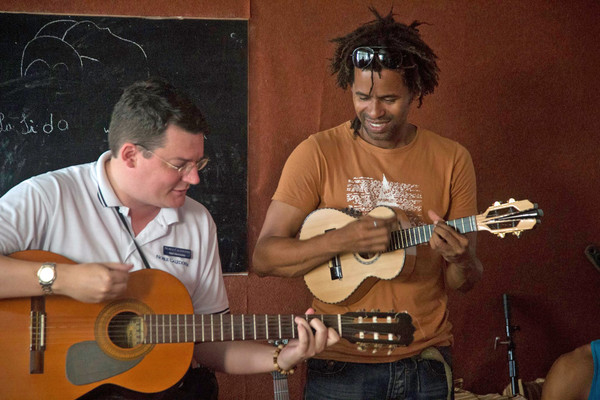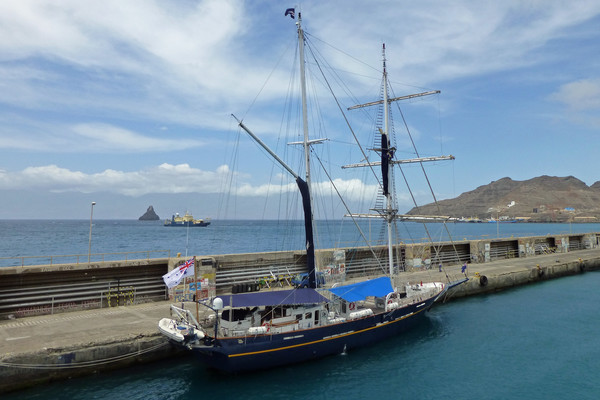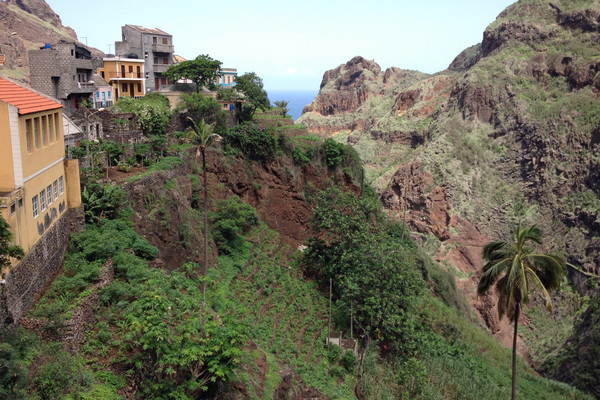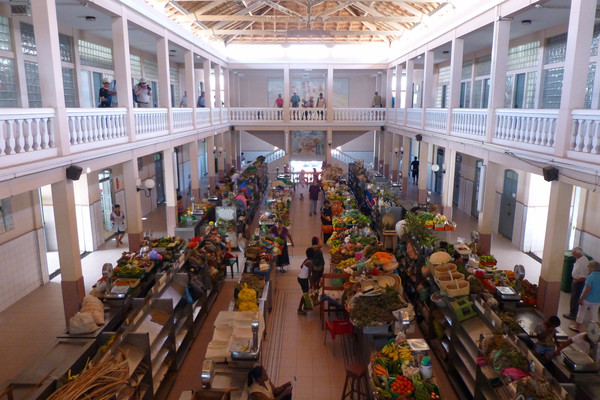Cape Verde - How can ten islands be so different?
Good afternoon everyone! I hope everybody is keeping well. It’s Tuesday 29th September and it’s hard to believe that another month is nearly over. Whilst this year will be memorable for a variety of reasons, I can’t help but feel that time travels faster when you’re in the same place all the time. I’m sure many will feel completely the opposite. I’ve not had a ‘regular’ full-time job since 2001, and it seems like only yesterday that it was incredibly hot, and now today I’ve been wearing every layer possible. Until now, due to working at sea, I never normally see the seasons change. It is usually summer and then winter, with rarely anything in between. I’ve been enjoying witnessing the leaves gradually begin to change colour, especially when the lo-lying sunlight catches them when I’m on an evening delivery run. Speaking of deliveries, there was much excitement at the depôt as brand new delivery trucks arrived. They are “70” registration plate with only a hundred miles on the clock. The managers told us that they have all the latest gadgets including DAB radio. I raised my hand and asked if they now have air-conditioning as the previous trucks didn’t. The manager said he would happily demonstrate the air-conditioning system to me. I eagerly followed him as he headed towards my allocated truck. He climbed into the driver’s seat and motioned that I should get in on the other side. I did so and he ran through a few of the new controls and then it arrived – the moment I’d been waiting for. “Shall I show you how the air-conditioning works?” He asked me. “Yes please”, I enthusiastically replied. “Well, there are two buttons that operate the air-conditioning on this vehicle. This one raises and lowers and right window, whilst this one raises and lowers the left window. Now don’t be so soft and get out there delivering!” I guess I should have known really. Still, I have felt quite smug driving around in a brand new vehicle. I have never owned a new car in my life, and never dreamt that the first new vehicle I would drive would be a Mercedes-Benz delivery truck!
Other activities I’ve been up to since I last wrote include a day of volunteering on the railway back on Friday. The trains do not have any form of heating so I was grateful for the thick pair of socks I’d chosen to wear (because all the others were waiting to be washed). I was on the very early morning shift on Saturday, but then took the opportunity to pop over the road to watch Hythe Town vs Chalfont St Peter in the FA Trophy 1st Qualifying Round. Attendance is limited to 400 so that everyone can be socially distanced. I was one of the 178 who braved the very chilly conditions to see Hythe run out 3-0 winners and set up a tie with nearby rivals Ashford United in the next round. Good luck to the Cannons!

| Kick-off as Hythe Town take on Chalfont St Peter |
All other activities have been Noble Caledonia related. My email account is back up and running again, so if you wrote in and did not receive a reply, then please feel free to try again. Apologies for any messages that were lost along the way. Late last night I finally finished the next travel quiz for elsewhere on the Travel Post. I chose to look at countries which are islands for the theme of the quiz. This made me think about one of those countries in particular, and the very happy memories from an extensive visit I made in 2015…
Cape Verde. Prior to visiting Cape Verde with the ‘Hebridean Sky’, I realised that I had been there three times before. 27th October 2007 (en route from Tenerife to Antigua), 1st May 2008 (en route from Antigua to Tenerife) and once to re-fuel at Sal whilst on a charter flight back from Argentina to London. I include that information here, as it is a very good demonstration of how many people view Cape Verde – as a stepping stone to somewhere else. This is quite understandable as that is the role it primarily served for centuries.

| A partially terraced valley, leading down to a pristine beach, on São Nicolau |
A little brief history of Cape Verde from a human settlement perspective tells us that the islands were discovered around 1456, with the first Portuguese settlers arriving six years later. From the 16th to the 19th century, the islands prospered from the Atlantic Slave Trade, and also as a re-fuelling point for ocean-going ships. The decline of the slave trade in the 19th century, combined with the opening of the Suez Canal in 1869, lead to economic decline and emigration. However, whilst many ships were lost to the Suez Canal, there was (and always will be) a need for stopover facilities for those sailing up and down the western side of Africa. Independence was attained in 1975, but there are still strong friendly links to Portugal.
So it was that my previous visits with a ship, back in 2007 and 2008, were a combination of both including somewhere on the trans-Atlantic run to visit, and the need to refuel the ship and replenish supplies. On those two calls we had passengers with us for “the crossing”. On both occasions we had stopped at Mindelo on the island of São Vicente. The photos I took on those two visits illustrate a barren, windswept, sandy and hilly island with not much to see. The other previous visit had been in the middle of the night on a long flight from Buenos Aires to London, and been for exactly the same reason – to refuel and replenish. Therefore it was with a feeling of trepidation and thinking that I would be underwhelmed that I landed in Cape Verde on 23rd September 2015 to be ready to welcome the passengers for their cruise around the archipelago. I could not have been more wrong.

| A traditional village dwelling on the island of São Nicolau |
I was scheduled to be Cruise Director for two Cape Verde cruises. The plan was to visit eight of the islands that make up the archipelago. The islands are spread out in a reverse “C” formation. From top left, going round to bottom left, in order they are: Santo Antão, São Vicente, Santa Luzia, São Nicolau, Sal, Boa Vista, Maio, Santiago, Fogo and Brava. Only Boa Vista and the uninhabited Santa Luzia were not part of our itinerary. There are a few other islets that bring the total area of Cape Verde up to 1,572 square miles – the equivalent of Suffolk in the UK.
The easiest way to look at the islands is for me to go round in the order that we first visited them, which means we will start near the top left with São Vicente. One of the many great things about Noble Caledonia is that no expense is spared when it comes to supplying the best local agents to handle our visits. In Cape Verde we were truly spoilt. I arrived two days before the passengers, and can clearly remember spending a sunny afternoon sat on a picnic bench in Mindelo, São Vicente, going through the itinerary with the agent. Her team would be following us round for the entire time we were in Cape Verde. They would be flying or sailing between the islands so that they would always be there to greet us on our arrival.

| Our minivans pause on the road to offer a view of the dramatic coastline of São Nicolau |
The passengers flew in on 25th September 2015 and I had the unusual experience of offering the guests a local show on their first evening. Normally, if we can source a local show, we try and do this later in the cruise. However, the local agents informed me that the best local show was here in São Vicente, and that I should take advantage of the offer. We moved the Welcome Briefing and dinner forward, and then made space on the Lido Deck for the local show to perform. The dancers came on board, changed into their exotic costumes, and delivered a mixture of dances, mostly centred around the famous ‘Capoeira’. Strictly speaking, the Capoeira is a martial art, rather than a dance, but it is fused with acrobatics and music to create a fascinating Afro-Brazilian cultural performance. Whilst having a local show on the first night, when passengers are usually tired from their flights is not my ideal scenario, on this occasion it worked beautifully. The warm balmy evening, the ice chinking in the gin and tonics, and watching a performance of Capoeira really did make the passengers realise they were now on holiday and there to appreciate all that these islands have to offer.

| The São Vicente ‘Local Show’ on the first night of the cruise |
Another very good idea is, if at all possible, to remain overnight in port on the first day. It guarantees a calm sea for everyone and a good night’s sleep. Very occasionally, there could be flight delays in passengers arriving, and to be able to have everyone relax on that first night and know they will have the chance to explore in the morning is a great asset. I can remember about ten years ago, being on a different cruise line on turnaround day in Havana. The passengers landed at Havana airport, came directly to the ship, and then we departed for two slow days at sea to Belize. I simply could not understand the logic behind it. Havana was easily the most fascinating place that we were visiting on that cruise, and the passengers only had the commentary from the coach as they drove from the airport to the ship. On rare occasions, it is unavoidable due to the port scheduling, and we have to leave fairly soon after the passengers have arrived. However, in those instances, I am so glad that Noble Caledonia offer pre-cruise and/or post-cruise extensions so that you have the opportunity to see more.
So it was with São Vicente. After a good night’s sleep, we set off the next morning to explore the island. The people of São Vicente will not be too offended if I say that it is not the most naturally beautiful of the Cape Verde islands. However, it is a vital island because of its location, and the large sheltered harbour at Mindelo. You could still see evidence of where the coal was stored to supply passing steam ships, and large oil containers were on hand for today’s vessels. Our city tour took in the colourful local markets, including the various catches of the day from the fishermen who we had seen returning to port whilst we had breakfast on the open deck. A welcome refreshment break in a shaded courtyard was enjoyed before we continued to the Museum of Art & Design and also admired some of the local Portuguese architecture.

| Looking through the window of the artists’ workshop at the Museum of Art & Design |
The highlight for me was a visit to the Cape Verdean Guitar Workshop. The craftsmen were three brothers, who were clearly devoted to their work. Receiving a guitar from them in Cape Verde would be the equivalent of an Italian receiving a violin made by Antonio Stradivari. They explained the various processes involved in making a Cape Verdean Guitar, and then performed a short concert together at the end of the presentation. I could not resist the temptation and asked if I could strum one of their guitars, and the photo that somebody took (apologies that I can’t remember who it was) and gave to me is one I have always treasured…

| Jamming with the Cape Verdean Guitar makers in their workshop |
When we arrived back at the port, ready to set sail that early evening, we had been joined on the berth by STS ‘Young Endeavour’. I was absolutely thrilled to see the ship, as I had heard so much about it. She was built in 1986/7 in Lowestoft, England, by the UK Government, to be presented to Australia on the occasion of the Australian Bicentenary in 1988. The Australian government decided that, whilst the ship would provide sail training to Australia’s youth, it would be operated and maintained by the Royal Australian Navy. The person who was sent to the UK to oversee the construction and be the first captain? That was former Noble Caledonia skipper, Captain Frank Allica. I’ve interviewed Captain Frank many times over the years in front of the ship’s passengers, and he has many a tale to tell about the launching of ‘Young Endeavour’. The two stories that stick in my mind were that, whilst she was being built, the shipyard in Lowestoft went bankrupt. Captain Frank was all but told that, if the Australian people still wanted the gift, then he had better find a way of finishing it! Being an incredibly resourceful chap, he did just that. The other story was that it was decided that the ship should make an appearance at Cowes Week before she sailed down to Australia. The Royal Family were attending the regatta, and the Duke of Edinburgh came alongside on a tender to visit the ship. Captain Frank showed him around and explained some of the difficulties they had encountered in the construction process. The Duke was very keen to listen, being a former naval man himself, and wished them well with their voyage to Australia. A tender came back alongside, the Duke boarded, and they waved him off. Five minutes later another tender came alongside. Somewhat puzzled, Captain Frank asked them what they were doing. “We’ve come to collect His Royal Highness”, came the reply. “Oh dear, we’ve sent him off on the wrong boat” – is the edited version of Captain Frank’s response. With that, the tender that had just pulled alongside made haste for the other boat which must have had a very confused crew aboard!

| Young Endeavour’ on the berth in São Vicente |
After a pleasant night at sea, we arrived the next morning, 27th September, on the island of São Nicolau. The contrast to São Vicente could not have been greater. We were suddenly in a world of lush vegetation. I can remember the constant rumble of the tyres of our minivans as we drove over the cobblestones that formed the majority of the roads on the island. We climbed up, through quite thick mist, to reach the view point overlooking the cultivated inner valley of the island. Villages clung to the hillside, which were carved out to make terraces for crops to be irrigated. The only other time I had seen that effect was on the front cover of my geography text book at secondary school.

| Villages dramatically cling to hillside in São Nicolau |
The sun burnt off the morning mist and we settled down for a splendid buffet lunch at a stunning little resort location, surrounded by glorious views. After lunch, we continued our scenic drive of the island, including passing through tunnels and cuttings which had been hacked out from the volcanic rock. We arrived at a coastal farm for yet more refreshments (although the drinks were very welcome as we all continued to adjust to the humidity). Future Cruise Director/Expedition Leader Dr Chris Edwards was part of the Expedition Team. Whilst he is highly knowledgeable about almost everything, his main field of expertise is geology, and he was in his element. The guides were very good, but Chris could take the geology to another level and would gather passengers around him at any given opportunity to explain what they were looking at, or standing on.

| Geologist Dr Chris Edwards holding the audience captivated with tales of volcanic rock |
All too soon it was time to head back to the ship. However, the passengers had been in Cape Verde for a little over 48 hours and already experienced such contrasts in terrain. The main consistent theme running through the visit so far was the instant natural friendliness of everyone we encountered. Perhaps living on small islands makes everyone behave a little better and be more courteous towards each other. Whatever it is, it felt very welcoming. We have only covered a couple of islands so far, and there are plenty more to come, so I will continue next week. Until then, goodbye for now…

| Colourful indoor market on Sao Vicente |
Click here to view details of our small ship Cape Verde cruises





